Case Study: Management of Borderline Personality Disorder & Recovery
VerifiedAdded on 2023/06/07
|13
|4195
|254
Case Study
AI Summary
This case study critically analyzes the assessment and management of a 23-year-old female patient, Lisa, diagnosed with Borderline Personality Disorder (BPD). The study uses the DSM-V criteria to confirm the diagnosis, highlighting Lisa's emotional dysregulation, instability in relationships, self-image issues, and self-harming tendencies. Nursing interventions focused on Dialectical Behavior Therapy (DBT) and mindfulness-based skills are described, including building rapport, outdoor therapy sessions, and relaxation techniques like yoga and reverse counting. The case study also addresses challenges faced during the intervention, such as Lisa's distrustful nature and mood swings, and emphasizes the importance of collaborative management between the patient and healthcare providers. The goal of the interventions was to improve Lisa's social functioning and overall mental health, with a focus on long-term recovery and safety.
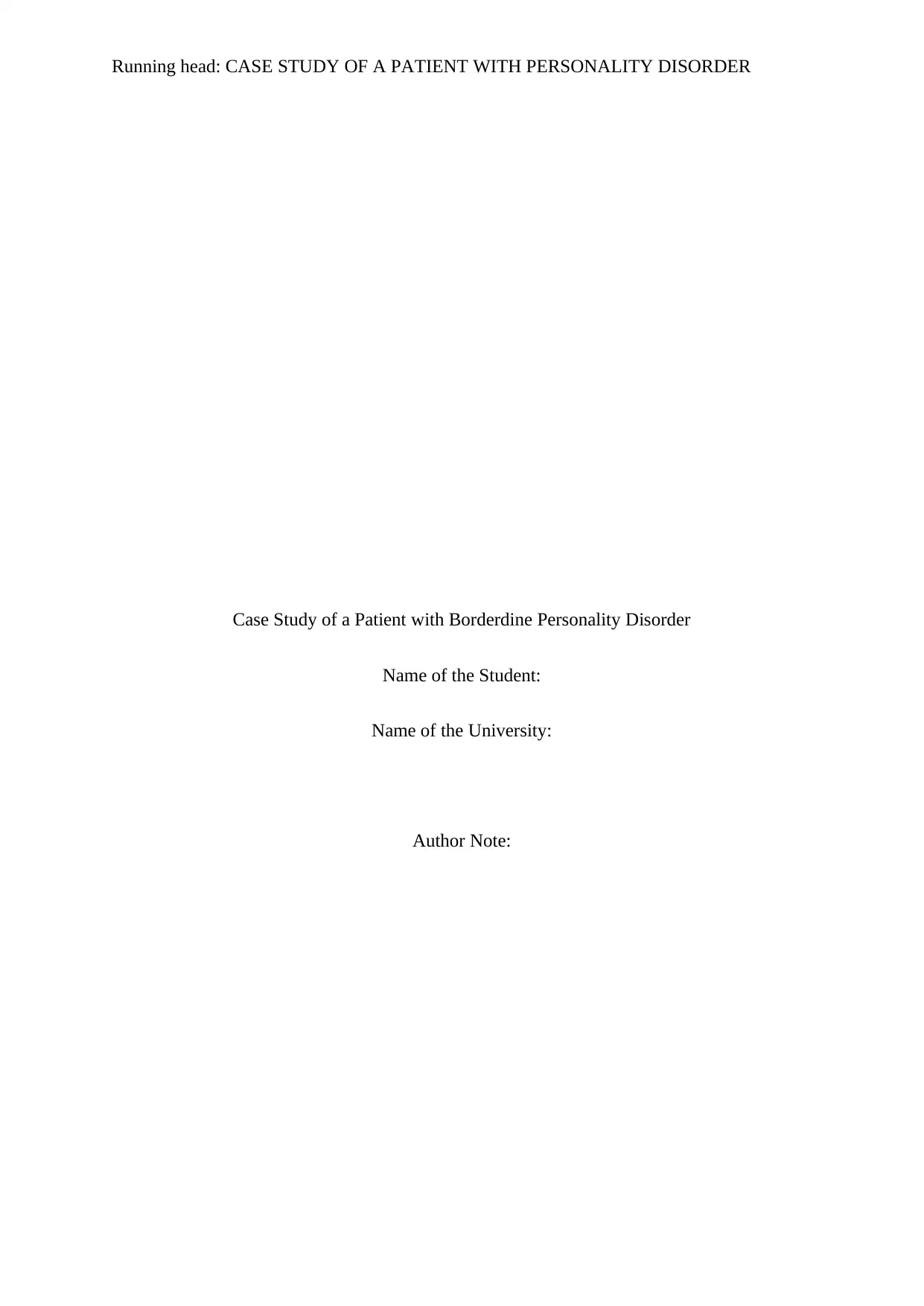
Running head: CASE STUDY OF A PATIENT WITH PERSONALITY DISORDER
Case Study of a Patient with Borderdine Personality Disorder
Name of the Student:
Name of the University:
Author Note:
Case Study of a Patient with Borderdine Personality Disorder
Name of the Student:
Name of the University:
Author Note:
Paraphrase This Document
Need a fresh take? Get an instant paraphrase of this document with our AI Paraphraser
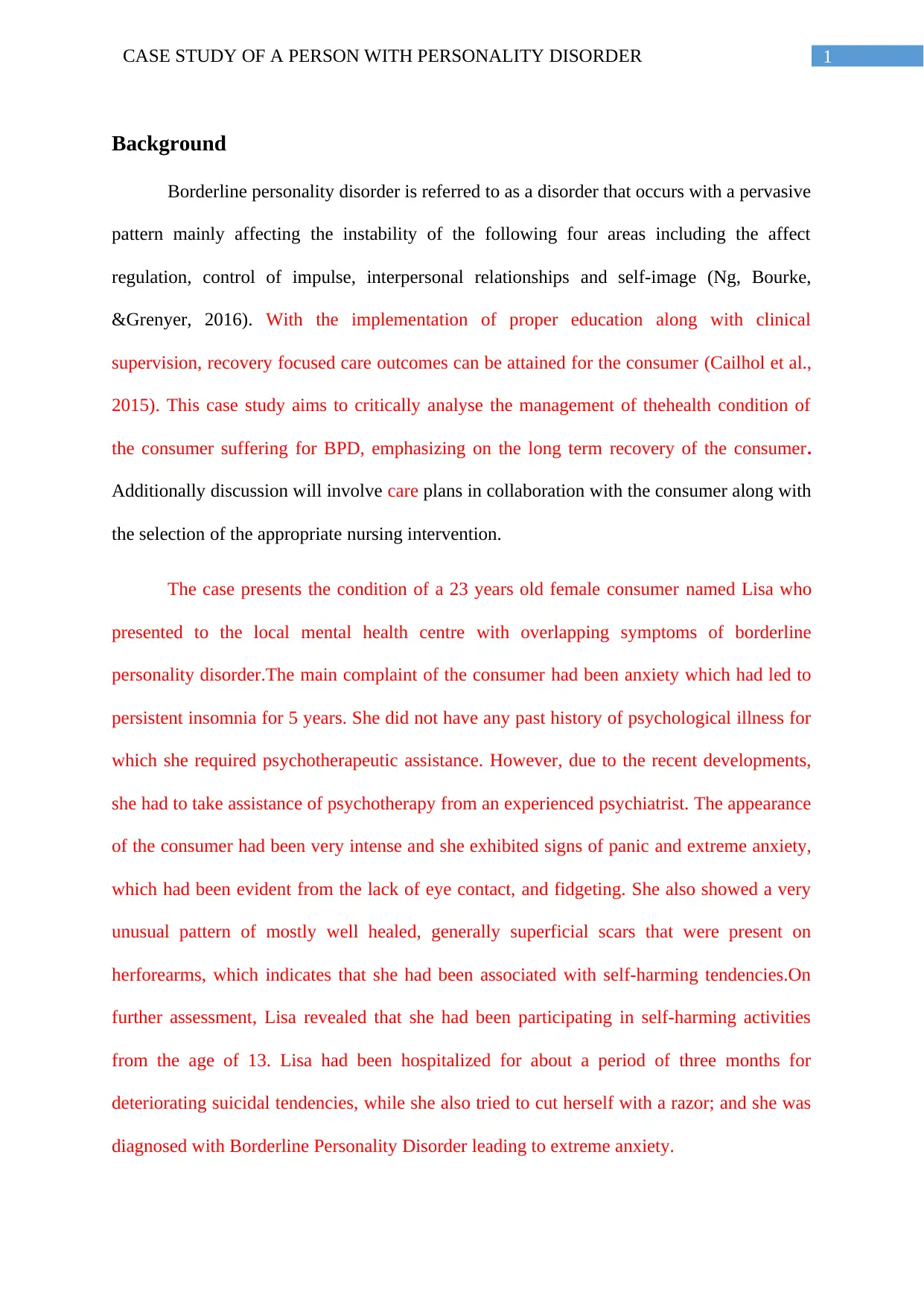
1CASE STUDY OF A PERSON WITH PERSONALITY DISORDER
Background
Borderline personality disorder is referred to as a disorder that occurs with a pervasive
pattern mainly affecting the instability of the following four areas including the affect
regulation, control of impulse, interpersonal relationships and self-image (Ng, Bourke,
&Grenyer, 2016). With the implementation of proper education along with clinical
supervision, recovery focused care outcomes can be attained for the consumer (Cailhol et al.,
2015). This case study aims to critically analyse the management of thehealth condition of
the consumer suffering for BPD, emphasizing on the long term recovery of the consumer.
Additionally discussion will involve care plans in collaboration with the consumer along with
the selection of the appropriate nursing intervention.
The case presents the condition of a 23 years old female consumer named Lisa who
presented to the local mental health centre with overlapping symptoms of borderline
personality disorder.The main complaint of the consumer had been anxiety which had led to
persistent insomnia for 5 years. She did not have any past history of psychological illness for
which she required psychotherapeutic assistance. However, due to the recent developments,
she had to take assistance of psychotherapy from an experienced psychiatrist. The appearance
of the consumer had been very intense and she exhibited signs of panic and extreme anxiety,
which had been evident from the lack of eye contact, and fidgeting. She also showed a very
unusual pattern of mostly well healed, generally superficial scars that were present on
herforearms, which indicates that she had been associated with self-harming tendencies.On
further assessment, Lisa revealed that she had been participating in self-harming activities
from the age of 13. Lisa had been hospitalized for about a period of three months for
deteriorating suicidal tendencies, while she also tried to cut herself with a razor; and she was
diagnosed with Borderline Personality Disorder leading to extreme anxiety.
Background
Borderline personality disorder is referred to as a disorder that occurs with a pervasive
pattern mainly affecting the instability of the following four areas including the affect
regulation, control of impulse, interpersonal relationships and self-image (Ng, Bourke,
&Grenyer, 2016). With the implementation of proper education along with clinical
supervision, recovery focused care outcomes can be attained for the consumer (Cailhol et al.,
2015). This case study aims to critically analyse the management of thehealth condition of
the consumer suffering for BPD, emphasizing on the long term recovery of the consumer.
Additionally discussion will involve care plans in collaboration with the consumer along with
the selection of the appropriate nursing intervention.
The case presents the condition of a 23 years old female consumer named Lisa who
presented to the local mental health centre with overlapping symptoms of borderline
personality disorder.The main complaint of the consumer had been anxiety which had led to
persistent insomnia for 5 years. She did not have any past history of psychological illness for
which she required psychotherapeutic assistance. However, due to the recent developments,
she had to take assistance of psychotherapy from an experienced psychiatrist. The appearance
of the consumer had been very intense and she exhibited signs of panic and extreme anxiety,
which had been evident from the lack of eye contact, and fidgeting. She also showed a very
unusual pattern of mostly well healed, generally superficial scars that were present on
herforearms, which indicates that she had been associated with self-harming tendencies.On
further assessment, Lisa revealed that she had been participating in self-harming activities
from the age of 13. Lisa had been hospitalized for about a period of three months for
deteriorating suicidal tendencies, while she also tried to cut herself with a razor; and she was
diagnosed with Borderline Personality Disorder leading to extreme anxiety.

2CASE STUDY OF A PERSON WITH PERSONALITY DISORDER
Diagnosis criteria
For the purpose of diagnosis of borderline personality disorder (BPD), the Diagnostic
and Statistical Manual of Mental Disorders V (2013) has been established in Australia.
Considering the symptoms like emotional dysregulation and enduring instability of affect
along with marked impulsivity and self-image and interpersonal relationships which are in
accordance to the above mentioned manual, helps to characterise the BPD diagnosis. The
DSM-V helps to stipulate the citerias which including the nine criterias that incidcates the
diagnosis which include the minimum five characterics to be diagosised. The patient Lisa
shows to meet all the mentioned criterias (Elwyn et al., 2014).
As per the DSM-V criteria, five fundamental symptoms including emotional
dysregulation, enduring instability of affect, self-image and interpersonal relationships, and
marked impulsivity are most vital signs of borderline personality disorders (DSM V criteria,
2018). In this case, Lisa had been suffering from depression and suicidality since her teenage,
and her insomnia also had been due to negative thoughts. Along with that, Lisa had
mentioned in the interview that even though she makes friends spontaneously, but these
relationships do not last and help her in the recovery. This indicates that she has acute
instability in life and meets criteria 2, enduring instability of affect. When questioned about
her self esteem issues, Lisa stated she feels unworthy and unloved, and she believes her
identity is only causing more stress and trouble to her family. This indicates that she suffers
from extreme self esteem issues, matching criteria of self image and identity issues. The
emotional dysregulation orf mood instability is exhibited by her swift change of topics in the
interview and randomly becoming tearful. And lastly, she had been enganing is self harming
and suivcvidal tendencies from a very young age proving the criteria for self harming
tendencies. Hence, Lisa matches with 5 crietria of BPD successfully, proving the diagnosis
correct (American Psychiatric Association, 2013).
Diagnosis criteria
For the purpose of diagnosis of borderline personality disorder (BPD), the Diagnostic
and Statistical Manual of Mental Disorders V (2013) has been established in Australia.
Considering the symptoms like emotional dysregulation and enduring instability of affect
along with marked impulsivity and self-image and interpersonal relationships which are in
accordance to the above mentioned manual, helps to characterise the BPD diagnosis. The
DSM-V helps to stipulate the citerias which including the nine criterias that incidcates the
diagnosis which include the minimum five characterics to be diagosised. The patient Lisa
shows to meet all the mentioned criterias (Elwyn et al., 2014).
As per the DSM-V criteria, five fundamental symptoms including emotional
dysregulation, enduring instability of affect, self-image and interpersonal relationships, and
marked impulsivity are most vital signs of borderline personality disorders (DSM V criteria,
2018). In this case, Lisa had been suffering from depression and suicidality since her teenage,
and her insomnia also had been due to negative thoughts. Along with that, Lisa had
mentioned in the interview that even though she makes friends spontaneously, but these
relationships do not last and help her in the recovery. This indicates that she has acute
instability in life and meets criteria 2, enduring instability of affect. When questioned about
her self esteem issues, Lisa stated she feels unworthy and unloved, and she believes her
identity is only causing more stress and trouble to her family. This indicates that she suffers
from extreme self esteem issues, matching criteria of self image and identity issues. The
emotional dysregulation orf mood instability is exhibited by her swift change of topics in the
interview and randomly becoming tearful. And lastly, she had been enganing is self harming
and suivcvidal tendencies from a very young age proving the criteria for self harming
tendencies. Hence, Lisa matches with 5 crietria of BPD successfully, proving the diagnosis
correct (American Psychiatric Association, 2013).
⊘ This is a preview!⊘
Do you want full access?
Subscribe today to unlock all pages.

Trusted by 1+ million students worldwide
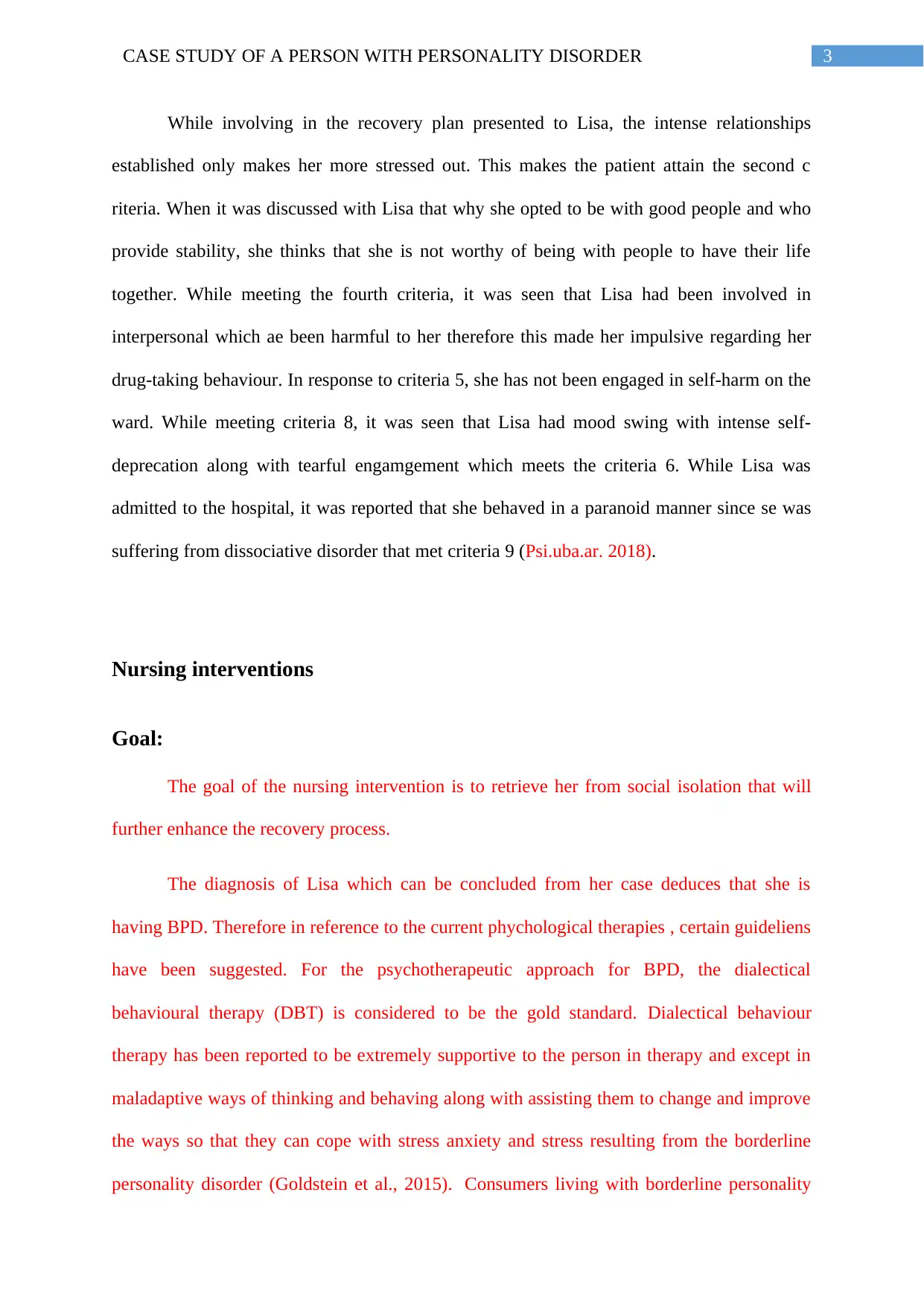
3CASE STUDY OF A PERSON WITH PERSONALITY DISORDER
While involving in the recovery plan presented to Lisa, the intense relationships
established only makes her more stressed out. This makes the patient attain the second c
riteria. When it was discussed with Lisa that why she opted to be with good people and who
provide stability, she thinks that she is not worthy of being with people to have their life
together. While meeting the fourth criteria, it was seen that Lisa had been involved in
interpersonal which ae been harmful to her therefore this made her impulsive regarding her
drug-taking behaviour. In response to criteria 5, she has not been engaged in self-harm on the
ward. While meeting criteria 8, it was seen that Lisa had mood swing with intense self-
deprecation along with tearful engamgement which meets the criteria 6. While Lisa was
admitted to the hospital, it was reported that she behaved in a paranoid manner since se was
suffering from dissociative disorder that met criteria 9 (Psi.uba.ar. 2018).
Nursing interventions
Goal:
The goal of the nursing intervention is to retrieve her from social isolation that will
further enhance the recovery process.
The diagnosis of Lisa which can be concluded from her case deduces that she is
having BPD. Therefore in reference to the current phychological therapies , certain guideliens
have been suggested. For the psychotherapeutic approach for BPD, the dialectical
behavioural therapy (DBT) is considered to be the gold standard. Dialectical behaviour
therapy has been reported to be extremely supportive to the person in therapy and except in
maladaptive ways of thinking and behaving along with assisting them to change and improve
the ways so that they can cope with stress anxiety and stress resulting from the borderline
personality disorder (Goldstein et al., 2015). Consumers living with borderline personality
While involving in the recovery plan presented to Lisa, the intense relationships
established only makes her more stressed out. This makes the patient attain the second c
riteria. When it was discussed with Lisa that why she opted to be with good people and who
provide stability, she thinks that she is not worthy of being with people to have their life
together. While meeting the fourth criteria, it was seen that Lisa had been involved in
interpersonal which ae been harmful to her therefore this made her impulsive regarding her
drug-taking behaviour. In response to criteria 5, she has not been engaged in self-harm on the
ward. While meeting criteria 8, it was seen that Lisa had mood swing with intense self-
deprecation along with tearful engamgement which meets the criteria 6. While Lisa was
admitted to the hospital, it was reported that she behaved in a paranoid manner since se was
suffering from dissociative disorder that met criteria 9 (Psi.uba.ar. 2018).
Nursing interventions
Goal:
The goal of the nursing intervention is to retrieve her from social isolation that will
further enhance the recovery process.
The diagnosis of Lisa which can be concluded from her case deduces that she is
having BPD. Therefore in reference to the current phychological therapies , certain guideliens
have been suggested. For the psychotherapeutic approach for BPD, the dialectical
behavioural therapy (DBT) is considered to be the gold standard. Dialectical behaviour
therapy has been reported to be extremely supportive to the person in therapy and except in
maladaptive ways of thinking and behaving along with assisting them to change and improve
the ways so that they can cope with stress anxiety and stress resulting from the borderline
personality disorder (Goldstein et al., 2015). Consumers living with borderline personality
Paraphrase This Document
Need a fresh take? Get an instant paraphrase of this document with our AI Paraphraser
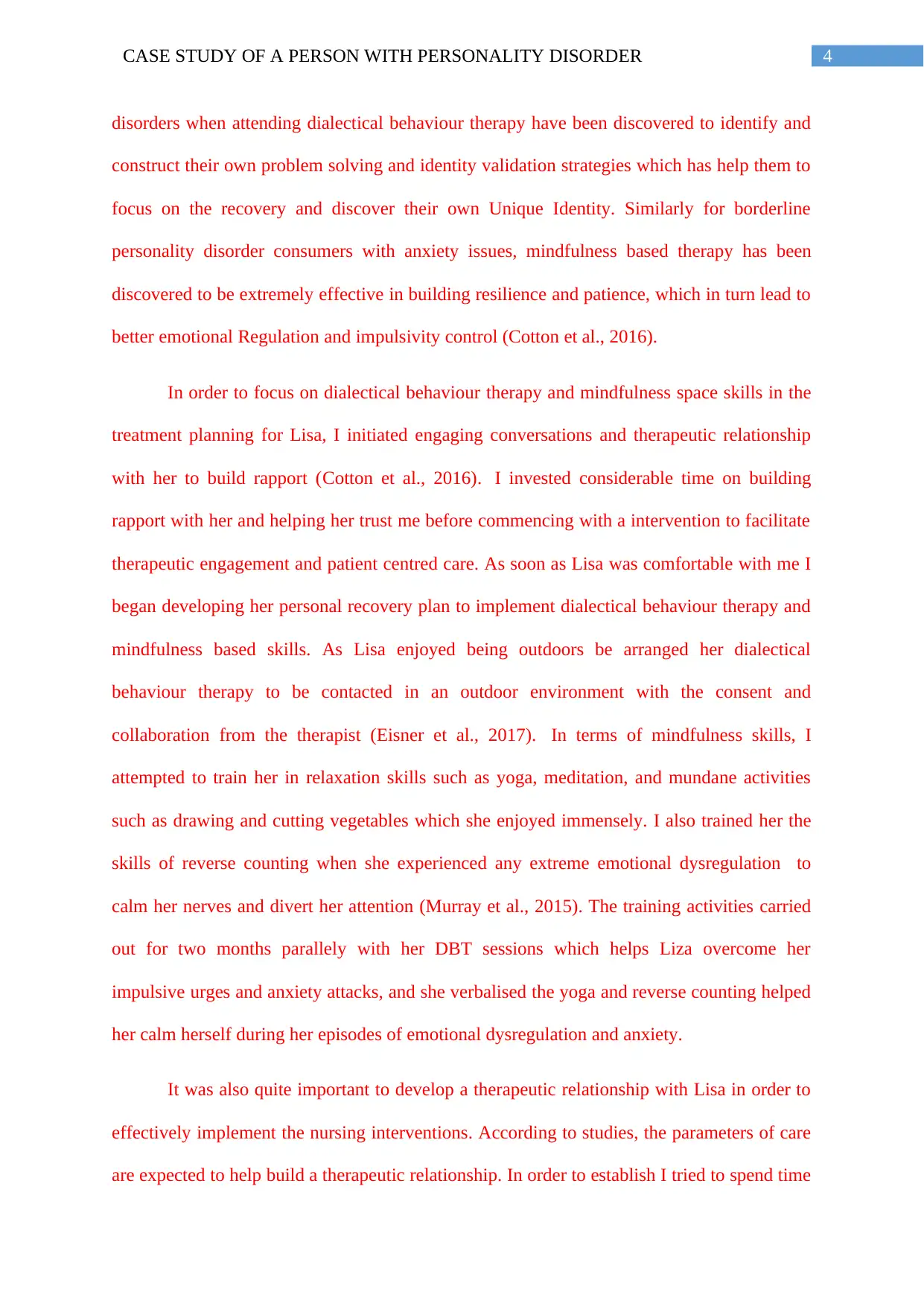
4CASE STUDY OF A PERSON WITH PERSONALITY DISORDER
disorders when attending dialectical behaviour therapy have been discovered to identify and
construct their own problem solving and identity validation strategies which has help them to
focus on the recovery and discover their own Unique Identity. Similarly for borderline
personality disorder consumers with anxiety issues, mindfulness based therapy has been
discovered to be extremely effective in building resilience and patience, which in turn lead to
better emotional Regulation and impulsivity control (Cotton et al., 2016).
In order to focus on dialectical behaviour therapy and mindfulness space skills in the
treatment planning for Lisa, I initiated engaging conversations and therapeutic relationship
with her to build rapport (Cotton et al., 2016). I invested considerable time on building
rapport with her and helping her trust me before commencing with a intervention to facilitate
therapeutic engagement and patient centred care. As soon as Lisa was comfortable with me I
began developing her personal recovery plan to implement dialectical behaviour therapy and
mindfulness based skills. As Lisa enjoyed being outdoors be arranged her dialectical
behaviour therapy to be contacted in an outdoor environment with the consent and
collaboration from the therapist (Eisner et al., 2017). In terms of mindfulness skills, I
attempted to train her in relaxation skills such as yoga, meditation, and mundane activities
such as drawing and cutting vegetables which she enjoyed immensely. I also trained her the
skills of reverse counting when she experienced any extreme emotional dysregulation to
calm her nerves and divert her attention (Murray et al., 2015). The training activities carried
out for two months parallely with her DBT sessions which helps Liza overcome her
impulsive urges and anxiety attacks, and she verbalised the yoga and reverse counting helped
her calm herself during her episodes of emotional dysregulation and anxiety.
It was also quite important to develop a therapeutic relationship with Lisa in order to
effectively implement the nursing interventions. According to studies, the parameters of care
are expected to help build a therapeutic relationship. In order to establish I tried to spend time
disorders when attending dialectical behaviour therapy have been discovered to identify and
construct their own problem solving and identity validation strategies which has help them to
focus on the recovery and discover their own Unique Identity. Similarly for borderline
personality disorder consumers with anxiety issues, mindfulness based therapy has been
discovered to be extremely effective in building resilience and patience, which in turn lead to
better emotional Regulation and impulsivity control (Cotton et al., 2016).
In order to focus on dialectical behaviour therapy and mindfulness space skills in the
treatment planning for Lisa, I initiated engaging conversations and therapeutic relationship
with her to build rapport (Cotton et al., 2016). I invested considerable time on building
rapport with her and helping her trust me before commencing with a intervention to facilitate
therapeutic engagement and patient centred care. As soon as Lisa was comfortable with me I
began developing her personal recovery plan to implement dialectical behaviour therapy and
mindfulness based skills. As Lisa enjoyed being outdoors be arranged her dialectical
behaviour therapy to be contacted in an outdoor environment with the consent and
collaboration from the therapist (Eisner et al., 2017). In terms of mindfulness skills, I
attempted to train her in relaxation skills such as yoga, meditation, and mundane activities
such as drawing and cutting vegetables which she enjoyed immensely. I also trained her the
skills of reverse counting when she experienced any extreme emotional dysregulation to
calm her nerves and divert her attention (Murray et al., 2015). The training activities carried
out for two months parallely with her DBT sessions which helps Liza overcome her
impulsive urges and anxiety attacks, and she verbalised the yoga and reverse counting helped
her calm herself during her episodes of emotional dysregulation and anxiety.
It was also quite important to develop a therapeutic relationship with Lisa in order to
effectively implement the nursing interventions. According to studies, the parameters of care
are expected to help build a therapeutic relationship. In order to establish I tried to spend time
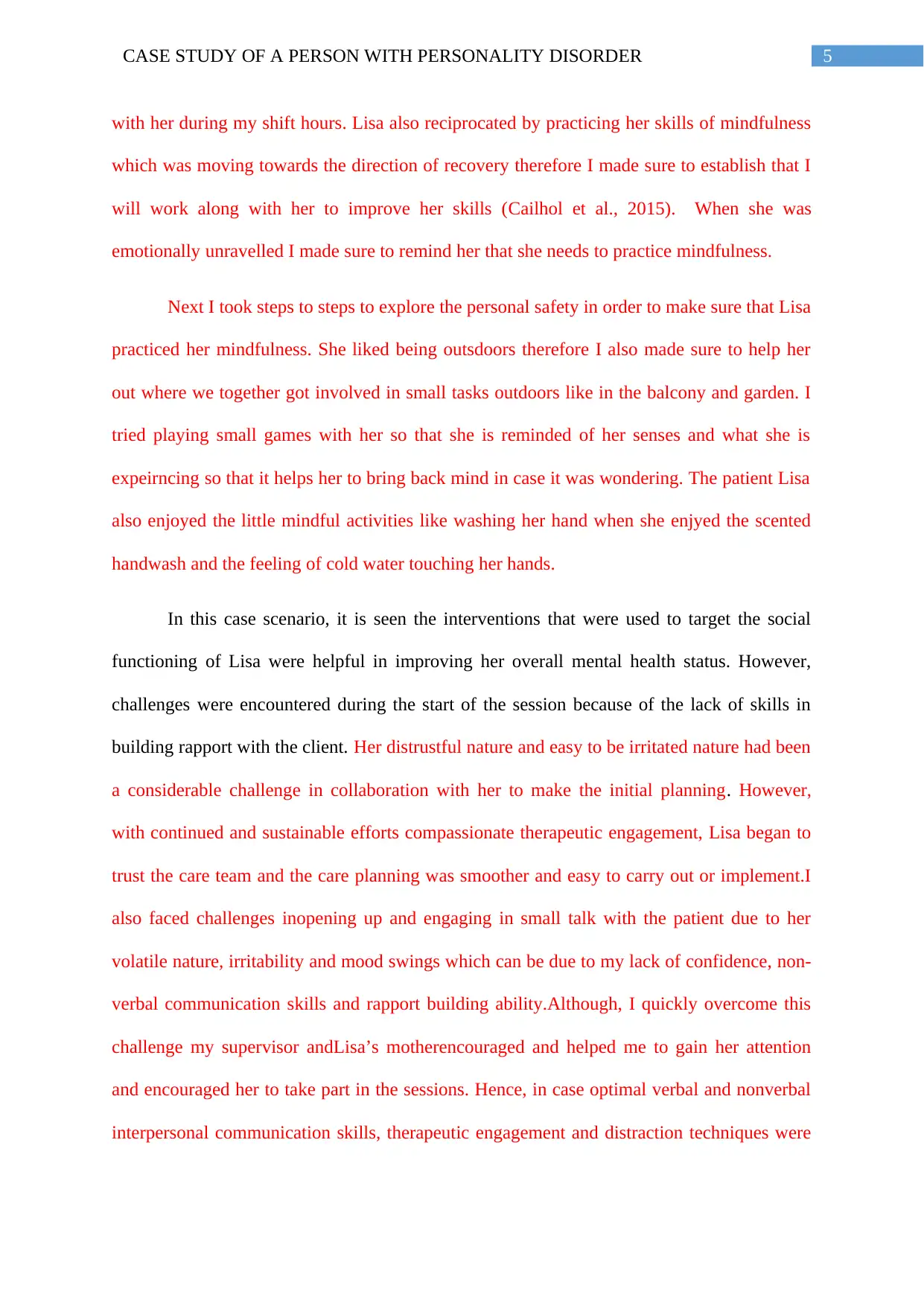
5CASE STUDY OF A PERSON WITH PERSONALITY DISORDER
with her during my shift hours. Lisa also reciprocated by practicing her skills of mindfulness
which was moving towards the direction of recovery therefore I made sure to establish that I
will work along with her to improve her skills (Cailhol et al., 2015). When she was
emotionally unravelled I made sure to remind her that she needs to practice mindfulness.
Next I took steps to steps to explore the personal safety in order to make sure that Lisa
practiced her mindfulness. She liked being outsdoors therefore I also made sure to help her
out where we together got involved in small tasks outdoors like in the balcony and garden. I
tried playing small games with her so that she is reminded of her senses and what she is
expeirncing so that it helps her to bring back mind in case it was wondering. The patient Lisa
also enjoyed the little mindful activities like washing her hand when she enjyed the scented
handwash and the feeling of cold water touching her hands.
In this case scenario, it is seen the interventions that were used to target the social
functioning of Lisa were helpful in improving her overall mental health status. However,
challenges were encountered during the start of the session because of the lack of skills in
building rapport with the client. Her distrustful nature and easy to be irritated nature had been
a considerable challenge in collaboration with her to make the initial planning. However,
with continued and sustainable efforts compassionate therapeutic engagement, Lisa began to
trust the care team and the care planning was smoother and easy to carry out or implement.I
also faced challenges inopening up and engaging in small talk with the patient due to her
volatile nature, irritability and mood swings which can be due to my lack of confidence, non-
verbal communication skills and rapport building ability.Although, I quickly overcome this
challenge my supervisor andLisa’s motherencouraged and helped me to gain her attention
and encouraged her to take part in the sessions. Hence, in case optimal verbal and nonverbal
interpersonal communication skills, therapeutic engagement and distraction techniques were
with her during my shift hours. Lisa also reciprocated by practicing her skills of mindfulness
which was moving towards the direction of recovery therefore I made sure to establish that I
will work along with her to improve her skills (Cailhol et al., 2015). When she was
emotionally unravelled I made sure to remind her that she needs to practice mindfulness.
Next I took steps to steps to explore the personal safety in order to make sure that Lisa
practiced her mindfulness. She liked being outsdoors therefore I also made sure to help her
out where we together got involved in small tasks outdoors like in the balcony and garden. I
tried playing small games with her so that she is reminded of her senses and what she is
expeirncing so that it helps her to bring back mind in case it was wondering. The patient Lisa
also enjoyed the little mindful activities like washing her hand when she enjyed the scented
handwash and the feeling of cold water touching her hands.
In this case scenario, it is seen the interventions that were used to target the social
functioning of Lisa were helpful in improving her overall mental health status. However,
challenges were encountered during the start of the session because of the lack of skills in
building rapport with the client. Her distrustful nature and easy to be irritated nature had been
a considerable challenge in collaboration with her to make the initial planning. However,
with continued and sustainable efforts compassionate therapeutic engagement, Lisa began to
trust the care team and the care planning was smoother and easy to carry out or implement.I
also faced challenges inopening up and engaging in small talk with the patient due to her
volatile nature, irritability and mood swings which can be due to my lack of confidence, non-
verbal communication skills and rapport building ability.Although, I quickly overcome this
challenge my supervisor andLisa’s motherencouraged and helped me to gain her attention
and encouraged her to take part in the sessions. Hence, in case optimal verbal and nonverbal
interpersonal communication skills, therapeutic engagement and distraction techniques were
⊘ This is a preview!⊘
Do you want full access?
Subscribe today to unlock all pages.

Trusted by 1+ million students worldwide

6CASE STUDY OF A PERSON WITH PERSONALITY DISORDER
used in this treatment from the beginning, Lisa’s recovery could have been faster (Dawson &
MacMillan, 2013).
In another way I tried helping Lisa by making hrer take choices which had positive
risks like the times her parents wanted to visit her. Lisa did not want them to visit her and
which often led to the deterioration of her mental health. However ideally there was a role of
her parents in her recovery process, therefore when they visited I tried to engage Lisa in
mindful activities. This also made her take the risk of becoming dysregulated since it was
made evident that this was worth the act since her parents could act as a support in the present
environment. Additionally it was also speculated her Lisa could use the mindful activities
after she was discharded from the hospital (Alvarez-Tomás et al., 2017).
In order to maintain the balance between the recovery of the patient along with
maintenance of the safety of the patient suffering from borderline personality disorder, being
a health professional it was required to follow certain guidelines which involved following
the evidence-based and the planned care for the patients. There was requirement of practise
redesign including in the appointments, the roles and the follow-up. This was followed by
patient education involving self management, behavioural change, psychological support and
the participation of the patient (Nathan & Gorman, 2015). There was also an implementation
of an expert system that required the provision of education and decision support along with
consultation. Finally there was requirement of proper information that included the
reminders, the outcomes, the feedbacks and the care planning. All these would help in the
improvement of the overall functions and the clinical outcomes. There is also a necessity to
focus on the collaborative management that is the collaboration between the patient and the
physician, which represents a model in which the health care providers are able to strengthen
and support the patients in a better way and promote self-care by patients suffering from such
behavioural issues (Larivière et al., 2015). In order to maintain he balance between this
used in this treatment from the beginning, Lisa’s recovery could have been faster (Dawson &
MacMillan, 2013).
In another way I tried helping Lisa by making hrer take choices which had positive
risks like the times her parents wanted to visit her. Lisa did not want them to visit her and
which often led to the deterioration of her mental health. However ideally there was a role of
her parents in her recovery process, therefore when they visited I tried to engage Lisa in
mindful activities. This also made her take the risk of becoming dysregulated since it was
made evident that this was worth the act since her parents could act as a support in the present
environment. Additionally it was also speculated her Lisa could use the mindful activities
after she was discharded from the hospital (Alvarez-Tomás et al., 2017).
In order to maintain the balance between the recovery of the patient along with
maintenance of the safety of the patient suffering from borderline personality disorder, being
a health professional it was required to follow certain guidelines which involved following
the evidence-based and the planned care for the patients. There was requirement of practise
redesign including in the appointments, the roles and the follow-up. This was followed by
patient education involving self management, behavioural change, psychological support and
the participation of the patient (Nathan & Gorman, 2015). There was also an implementation
of an expert system that required the provision of education and decision support along with
consultation. Finally there was requirement of proper information that included the
reminders, the outcomes, the feedbacks and the care planning. All these would help in the
improvement of the overall functions and the clinical outcomes. There is also a necessity to
focus on the collaborative management that is the collaboration between the patient and the
physician, which represents a model in which the health care providers are able to strengthen
and support the patients in a better way and promote self-care by patients suffering from such
behavioural issues (Larivière et al., 2015). In order to maintain he balance between this
Paraphrase This Document
Need a fresh take? Get an instant paraphrase of this document with our AI Paraphraser
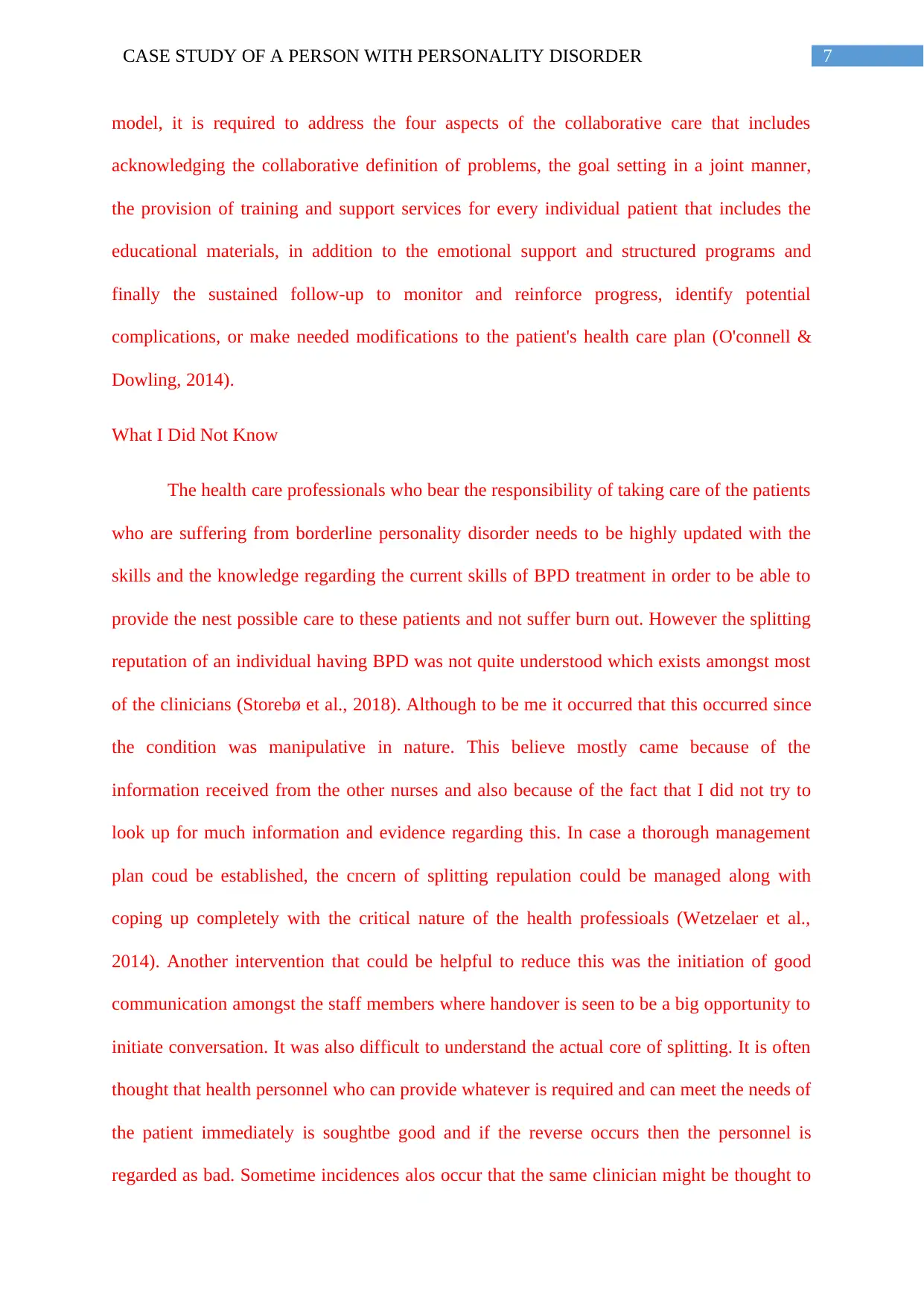
7CASE STUDY OF A PERSON WITH PERSONALITY DISORDER
model, it is required to address the four aspects of the collaborative care that includes
acknowledging the collaborative definition of problems, the goal setting in a joint manner,
the provision of training and support services for every individual patient that includes the
educational materials, in addition to the emotional support and structured programs and
finally the sustained follow-up to monitor and reinforce progress, identify potential
complications, or make needed modifications to the patient's health care plan (O'connell &
Dowling, 2014).
What I Did Not Know
The health care professionals who bear the responsibility of taking care of the patients
who are suffering from borderline personality disorder needs to be highly updated with the
skills and the knowledge regarding the current skills of BPD treatment in order to be able to
provide the nest possible care to these patients and not suffer burn out. However the splitting
reputation of an individual having BPD was not quite understood which exists amongst most
of the clinicians (Storebø et al., 2018). Although to be me it occurred that this occurred since
the condition was manipulative in nature. This believe mostly came because of the
information received from the other nurses and also because of the fact that I did not try to
look up for much information and evidence regarding this. In case a thorough management
plan coud be established, the cncern of splitting repulation could be managed along with
coping up completely with the critical nature of the health professioals (Wetzelaer et al.,
2014). Another intervention that could be helpful to reduce this was the initiation of good
communication amongst the staff members where handover is seen to be a big opportunity to
initiate conversation. It was also difficult to understand the actual core of splitting. It is often
thought that health personnel who can provide whatever is required and can meet the needs of
the patient immediately is soughtbe good and if the reverse occurs then the personnel is
regarded as bad. Sometime incidences alos occur that the same clinician might be thought to
model, it is required to address the four aspects of the collaborative care that includes
acknowledging the collaborative definition of problems, the goal setting in a joint manner,
the provision of training and support services for every individual patient that includes the
educational materials, in addition to the emotional support and structured programs and
finally the sustained follow-up to monitor and reinforce progress, identify potential
complications, or make needed modifications to the patient's health care plan (O'connell &
Dowling, 2014).
What I Did Not Know
The health care professionals who bear the responsibility of taking care of the patients
who are suffering from borderline personality disorder needs to be highly updated with the
skills and the knowledge regarding the current skills of BPD treatment in order to be able to
provide the nest possible care to these patients and not suffer burn out. However the splitting
reputation of an individual having BPD was not quite understood which exists amongst most
of the clinicians (Storebø et al., 2018). Although to be me it occurred that this occurred since
the condition was manipulative in nature. This believe mostly came because of the
information received from the other nurses and also because of the fact that I did not try to
look up for much information and evidence regarding this. In case a thorough management
plan coud be established, the cncern of splitting repulation could be managed along with
coping up completely with the critical nature of the health professioals (Wetzelaer et al.,
2014). Another intervention that could be helpful to reduce this was the initiation of good
communication amongst the staff members where handover is seen to be a big opportunity to
initiate conversation. It was also difficult to understand the actual core of splitting. It is often
thought that health personnel who can provide whatever is required and can meet the needs of
the patient immediately is soughtbe good and if the reverse occurs then the personnel is
regarded as bad. Sometime incidences alos occur that the same clinician might be thought to
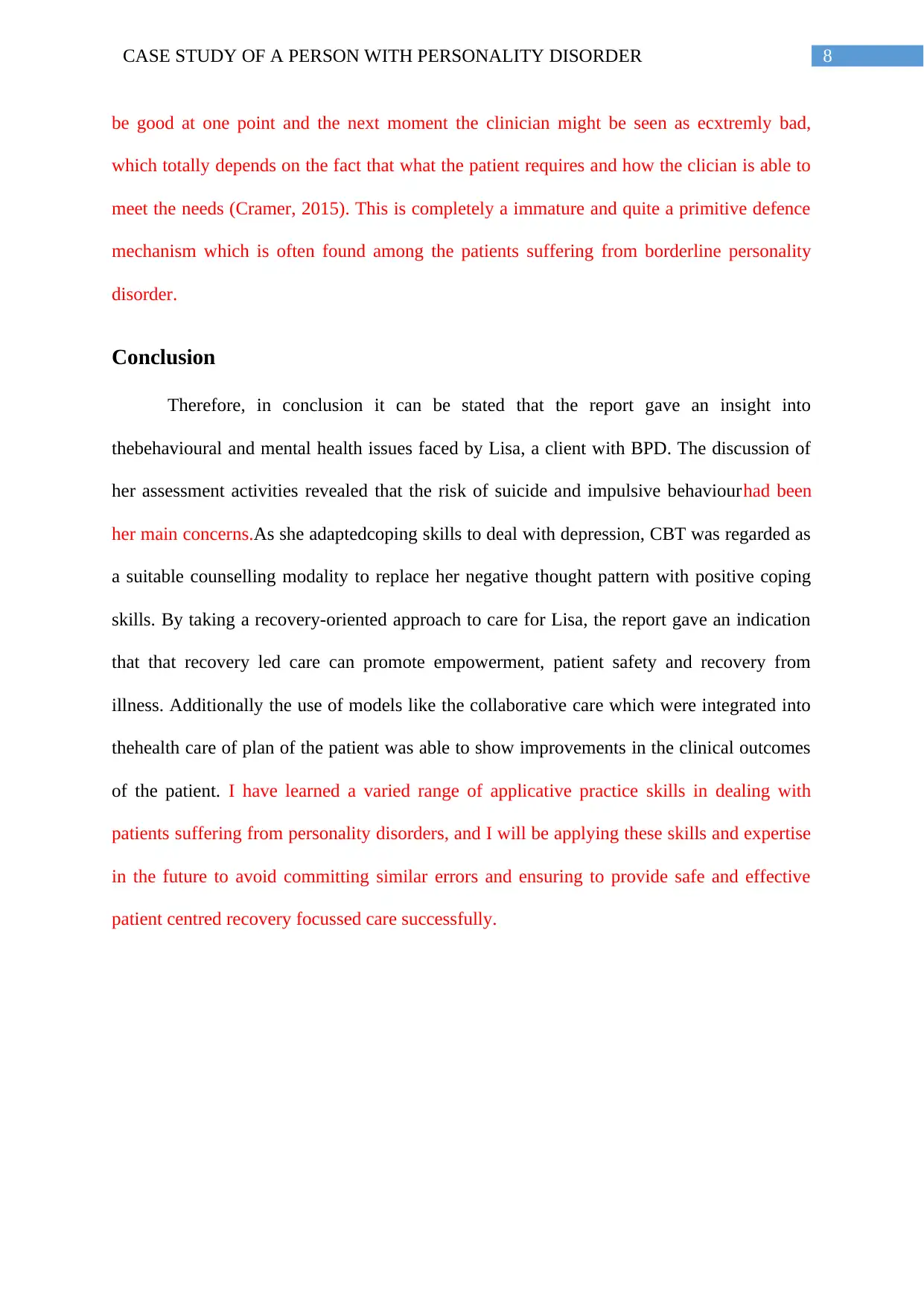
8CASE STUDY OF A PERSON WITH PERSONALITY DISORDER
be good at one point and the next moment the clinician might be seen as ecxtremly bad,
which totally depends on the fact that what the patient requires and how the clician is able to
meet the needs (Cramer, 2015). This is completely a immature and quite a primitive defence
mechanism which is often found among the patients suffering from borderline personality
disorder.
Conclusion
Therefore, in conclusion it can be stated that the report gave an insight into
thebehavioural and mental health issues faced by Lisa, a client with BPD. The discussion of
her assessment activities revealed that the risk of suicide and impulsive behaviourhad been
her main concerns.As she adaptedcoping skills to deal with depression, CBT was regarded as
a suitable counselling modality to replace her negative thought pattern with positive coping
skills. By taking a recovery-oriented approach to care for Lisa, the report gave an indication
that that recovery led care can promote empowerment, patient safety and recovery from
illness. Additionally the use of models like the collaborative care which were integrated into
thehealth care of plan of the patient was able to show improvements in the clinical outcomes
of the patient. I have learned a varied range of applicative practice skills in dealing with
patients suffering from personality disorders, and I will be applying these skills and expertise
in the future to avoid committing similar errors and ensuring to provide safe and effective
patient centred recovery focussed care successfully.
be good at one point and the next moment the clinician might be seen as ecxtremly bad,
which totally depends on the fact that what the patient requires and how the clician is able to
meet the needs (Cramer, 2015). This is completely a immature and quite a primitive defence
mechanism which is often found among the patients suffering from borderline personality
disorder.
Conclusion
Therefore, in conclusion it can be stated that the report gave an insight into
thebehavioural and mental health issues faced by Lisa, a client with BPD. The discussion of
her assessment activities revealed that the risk of suicide and impulsive behaviourhad been
her main concerns.As she adaptedcoping skills to deal with depression, CBT was regarded as
a suitable counselling modality to replace her negative thought pattern with positive coping
skills. By taking a recovery-oriented approach to care for Lisa, the report gave an indication
that that recovery led care can promote empowerment, patient safety and recovery from
illness. Additionally the use of models like the collaborative care which were integrated into
thehealth care of plan of the patient was able to show improvements in the clinical outcomes
of the patient. I have learned a varied range of applicative practice skills in dealing with
patients suffering from personality disorders, and I will be applying these skills and expertise
in the future to avoid committing similar errors and ensuring to provide safe and effective
patient centred recovery focussed care successfully.
⊘ This is a preview!⊘
Do you want full access?
Subscribe today to unlock all pages.

Trusted by 1+ million students worldwide
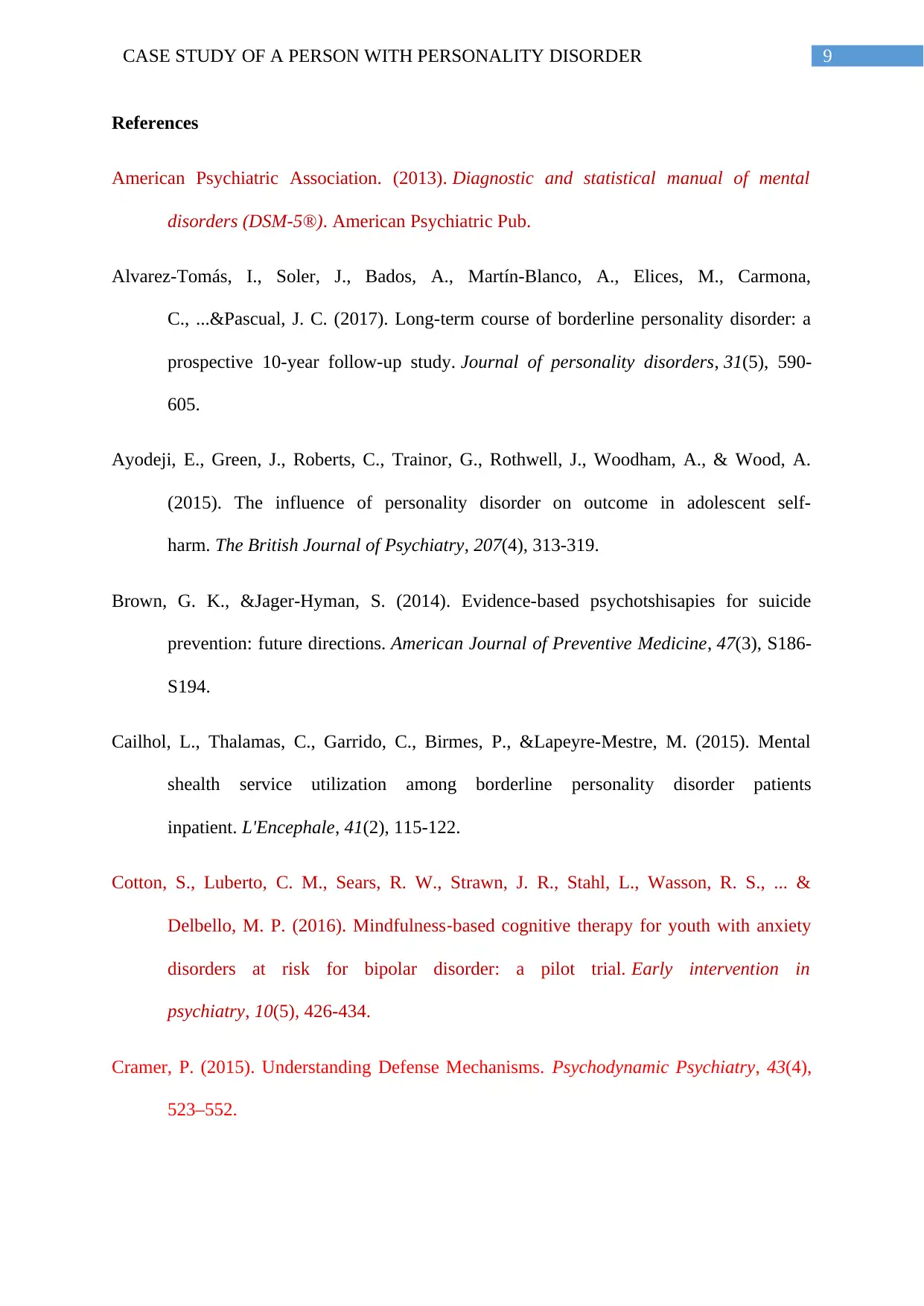
9CASE STUDY OF A PERSON WITH PERSONALITY DISORDER
References
American Psychiatric Association. (2013). Diagnostic and statistical manual of mental
disorders (DSM-5®). American Psychiatric Pub.
Alvarez-Tomás, I., Soler, J., Bados, A., Martín-Blanco, A., Elices, M., Carmona,
C., ...&Pascual, J. C. (2017). Long-term course of borderline personality disorder: a
prospective 10-year follow-up study. Journal of personality disorders, 31(5), 590-
605.
Ayodeji, E., Green, J., Roberts, C., Trainor, G., Rothwell, J., Woodham, A., & Wood, A.
(2015). The influence of personality disorder on outcome in adolescent self-
harm. The British Journal of Psychiatry, 207(4), 313-319.
Brown, G. K., &Jager-Hyman, S. (2014). Evidence-based psychotshisapies for suicide
prevention: future directions. American Journal of Preventive Medicine, 47(3), S186-
S194.
Cailhol, L., Thalamas, C., Garrido, C., Birmes, P., &Lapeyre-Mestre, M. (2015). Mental
shealth service utilization among borderline personality disorder patients
inpatient. L'Encephale, 41(2), 115-122.
Cotton, S., Luberto, C. M., Sears, R. W., Strawn, J. R., Stahl, L., Wasson, R. S., ... &
Delbello, M. P. (2016). Mindfulness‐based cognitive therapy for youth with anxiety
disorders at risk for bipolar disorder: a pilot trial. Early intervention in
psychiatry, 10(5), 426-434.
Cramer, P. (2015). Understanding Defense Mechanisms. Psychodynamic Psychiatry, 43(4),
523–552.
References
American Psychiatric Association. (2013). Diagnostic and statistical manual of mental
disorders (DSM-5®). American Psychiatric Pub.
Alvarez-Tomás, I., Soler, J., Bados, A., Martín-Blanco, A., Elices, M., Carmona,
C., ...&Pascual, J. C. (2017). Long-term course of borderline personality disorder: a
prospective 10-year follow-up study. Journal of personality disorders, 31(5), 590-
605.
Ayodeji, E., Green, J., Roberts, C., Trainor, G., Rothwell, J., Woodham, A., & Wood, A.
(2015). The influence of personality disorder on outcome in adolescent self-
harm. The British Journal of Psychiatry, 207(4), 313-319.
Brown, G. K., &Jager-Hyman, S. (2014). Evidence-based psychotshisapies for suicide
prevention: future directions. American Journal of Preventive Medicine, 47(3), S186-
S194.
Cailhol, L., Thalamas, C., Garrido, C., Birmes, P., &Lapeyre-Mestre, M. (2015). Mental
shealth service utilization among borderline personality disorder patients
inpatient. L'Encephale, 41(2), 115-122.
Cotton, S., Luberto, C. M., Sears, R. W., Strawn, J. R., Stahl, L., Wasson, R. S., ... &
Delbello, M. P. (2016). Mindfulness‐based cognitive therapy for youth with anxiety
disorders at risk for bipolar disorder: a pilot trial. Early intervention in
psychiatry, 10(5), 426-434.
Cramer, P. (2015). Understanding Defense Mechanisms. Psychodynamic Psychiatry, 43(4),
523–552.
Paraphrase This Document
Need a fresh take? Get an instant paraphrase of this document with our AI Paraphraser
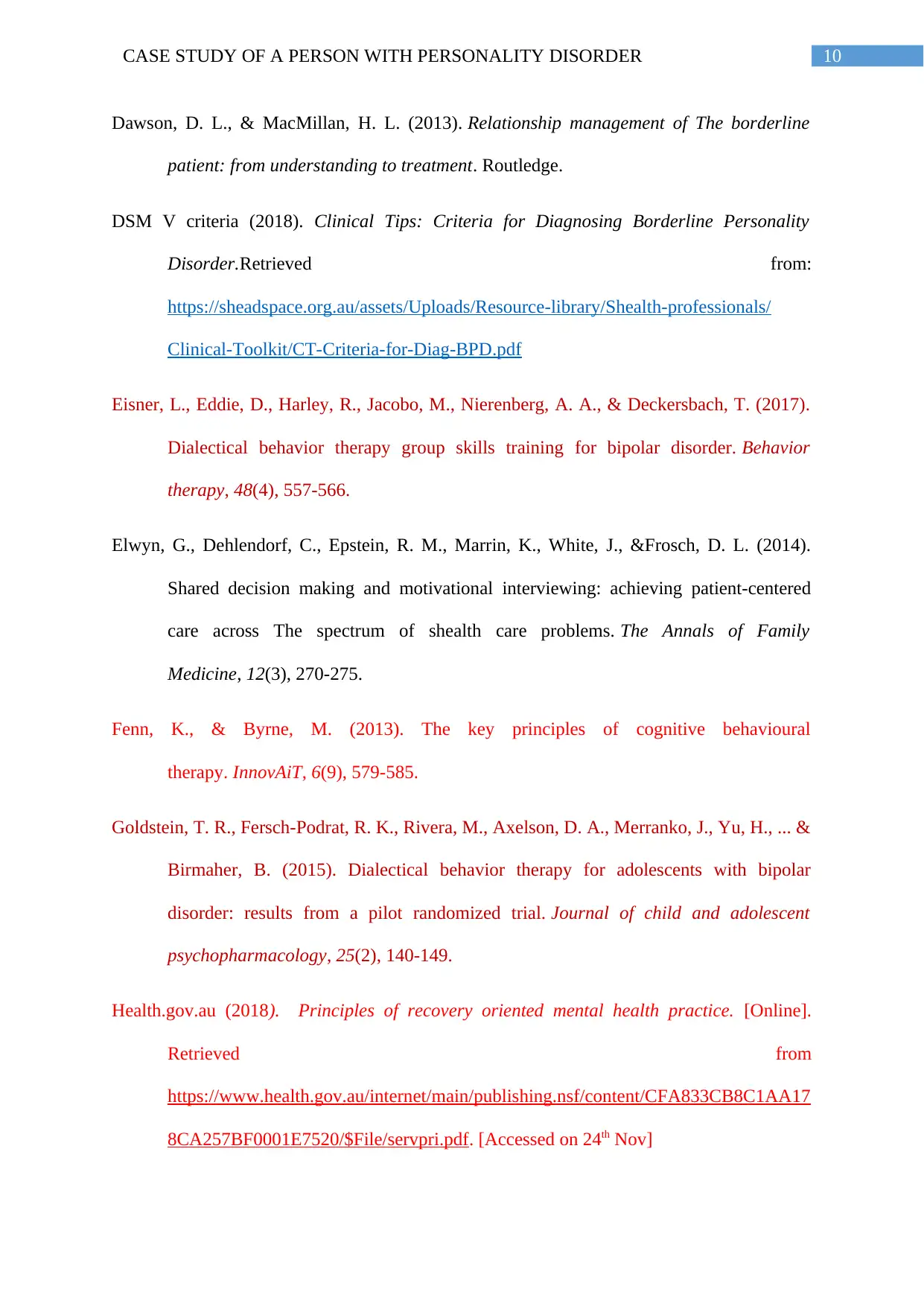
10CASE STUDY OF A PERSON WITH PERSONALITY DISORDER
Dawson, D. L., & MacMillan, H. L. (2013). Relationship management of The borderline
patient: from understanding to treatment. Routledge.
DSM V criteria (2018). Clinical Tips: Criteria for Diagnosing Borderline Personality
Disorder.Retrieved from:
https://sheadspace.org.au/assets/Uploads/Resource-library/Shealth-professionals/
Clinical-Toolkit/CT-Criteria-for-Diag-BPD.pdf
Eisner, L., Eddie, D., Harley, R., Jacobo, M., Nierenberg, A. A., & Deckersbach, T. (2017).
Dialectical behavior therapy group skills training for bipolar disorder. Behavior
therapy, 48(4), 557-566.
Elwyn, G., Dehlendorf, C., Epstein, R. M., Marrin, K., White, J., &Frosch, D. L. (2014).
Shared decision making and motivational interviewing: achieving patient-centered
care across The spectrum of shealth care problems. The Annals of Family
Medicine, 12(3), 270-275.
Fenn, K., & Byrne, M. (2013). The key principles of cognitive behavioural
therapy. InnovAiT, 6(9), 579-585.
Goldstein, T. R., Fersch-Podrat, R. K., Rivera, M., Axelson, D. A., Merranko, J., Yu, H., ... &
Birmaher, B. (2015). Dialectical behavior therapy for adolescents with bipolar
disorder: results from a pilot randomized trial. Journal of child and adolescent
psychopharmacology, 25(2), 140-149.
Health.gov.au (2018). Principles of recovery oriented mental health practice. [Online].
Retrieved from
https://www.health.gov.au/internet/main/publishing.nsf/content/CFA833CB8C1AA17
8CA257BF0001E7520/$File/servpri.pdf. [Accessed on 24th Nov]
Dawson, D. L., & MacMillan, H. L. (2013). Relationship management of The borderline
patient: from understanding to treatment. Routledge.
DSM V criteria (2018). Clinical Tips: Criteria for Diagnosing Borderline Personality
Disorder.Retrieved from:
https://sheadspace.org.au/assets/Uploads/Resource-library/Shealth-professionals/
Clinical-Toolkit/CT-Criteria-for-Diag-BPD.pdf
Eisner, L., Eddie, D., Harley, R., Jacobo, M., Nierenberg, A. A., & Deckersbach, T. (2017).
Dialectical behavior therapy group skills training for bipolar disorder. Behavior
therapy, 48(4), 557-566.
Elwyn, G., Dehlendorf, C., Epstein, R. M., Marrin, K., White, J., &Frosch, D. L. (2014).
Shared decision making and motivational interviewing: achieving patient-centered
care across The spectrum of shealth care problems. The Annals of Family
Medicine, 12(3), 270-275.
Fenn, K., & Byrne, M. (2013). The key principles of cognitive behavioural
therapy. InnovAiT, 6(9), 579-585.
Goldstein, T. R., Fersch-Podrat, R. K., Rivera, M., Axelson, D. A., Merranko, J., Yu, H., ... &
Birmaher, B. (2015). Dialectical behavior therapy for adolescents with bipolar
disorder: results from a pilot randomized trial. Journal of child and adolescent
psychopharmacology, 25(2), 140-149.
Health.gov.au (2018). Principles of recovery oriented mental health practice. [Online].
Retrieved from
https://www.health.gov.au/internet/main/publishing.nsf/content/CFA833CB8C1AA17
8CA257BF0001E7520/$File/servpri.pdf. [Accessed on 24th Nov]

11CASE STUDY OF A PERSON WITH PERSONALITY DISORDER
Larivière, N., Couture, É., Blackburn, C., Carbonneau, M., Lacombe, C., Schinck, S. A., ... &
St-Cyr-Tribble, D. (2015). Recovery, as experienced by women with borderline
personality disorder. Psychiatric Quarterly, 86(4), 555-568.
May, J. M., Richardi, T. M., & Barth, K. S. (2016). Dialectical behaviortshisapy as treatment
for borderline personality disorder. Mental Shealth Clinician, 6(2), 62-67.
Menon, P., Chaudhari, B., Saldanha, D., Devabhaktuni, S., & Bhattacharya, L. (2016).
Childhood sexual abuse in adult patients with borderline personality
disorder. Industrial Psychiatry Journal, 25(1), 101–106. http://doi.org/10.4103/0972-
6748.196046
Meuldijk, D., McCarthy, A., Bourke, M. E., &Grenyer, B. F. (2017). The value of
psychological treatment for borderline personality disorder: Systematic review and
cost offset analysis of economic evaluations. PloS one, 12(3), e0171592.
Murray, G., Leitan, N. D., Berk, M., Thomas, N., Michalak, E., Berk, L., ... & Kyrios, M.
(2015). Online mindfulness-based intervention for late-stage bipolar disorder: pilot
evidence for feasibility and effectiveness. Journal of affective disorders, 178, 46-51.
Nathan, P. E., & Gorman, J. M. (Eds.). (2015). A guide to treatments that work. Oxford
University Press.
Ng, F. Y., Bourke, M. E., &Grenyer, B. F. (2016). Recovery from borderline personality
disorder: A systematic review of The perspectives of consumers, clinicians, family
and carers. PloS one, 11(8), e0160515.
Niesten, I. J., Karan, E., Frankenburg, F. R., Fitzmaurice, G. M., &Zanarini, M. C. (2016).
Description and prediction of The income status of borderline patients over 10 years
of prospective follow‐up. Personality and mental shealth, 10(4), 285-292.
Larivière, N., Couture, É., Blackburn, C., Carbonneau, M., Lacombe, C., Schinck, S. A., ... &
St-Cyr-Tribble, D. (2015). Recovery, as experienced by women with borderline
personality disorder. Psychiatric Quarterly, 86(4), 555-568.
May, J. M., Richardi, T. M., & Barth, K. S. (2016). Dialectical behaviortshisapy as treatment
for borderline personality disorder. Mental Shealth Clinician, 6(2), 62-67.
Menon, P., Chaudhari, B., Saldanha, D., Devabhaktuni, S., & Bhattacharya, L. (2016).
Childhood sexual abuse in adult patients with borderline personality
disorder. Industrial Psychiatry Journal, 25(1), 101–106. http://doi.org/10.4103/0972-
6748.196046
Meuldijk, D., McCarthy, A., Bourke, M. E., &Grenyer, B. F. (2017). The value of
psychological treatment for borderline personality disorder: Systematic review and
cost offset analysis of economic evaluations. PloS one, 12(3), e0171592.
Murray, G., Leitan, N. D., Berk, M., Thomas, N., Michalak, E., Berk, L., ... & Kyrios, M.
(2015). Online mindfulness-based intervention for late-stage bipolar disorder: pilot
evidence for feasibility and effectiveness. Journal of affective disorders, 178, 46-51.
Nathan, P. E., & Gorman, J. M. (Eds.). (2015). A guide to treatments that work. Oxford
University Press.
Ng, F. Y., Bourke, M. E., &Grenyer, B. F. (2016). Recovery from borderline personality
disorder: A systematic review of The perspectives of consumers, clinicians, family
and carers. PloS one, 11(8), e0160515.
Niesten, I. J., Karan, E., Frankenburg, F. R., Fitzmaurice, G. M., &Zanarini, M. C. (2016).
Description and prediction of The income status of borderline patients over 10 years
of prospective follow‐up. Personality and mental shealth, 10(4), 285-292.
⊘ This is a preview!⊘
Do you want full access?
Subscribe today to unlock all pages.

Trusted by 1+ million students worldwide
1 out of 13
Related Documents
Your All-in-One AI-Powered Toolkit for Academic Success.
+13062052269
info@desklib.com
Available 24*7 on WhatsApp / Email
![[object Object]](/_next/static/media/star-bottom.7253800d.svg)
Unlock your academic potential
Copyright © 2020–2025 A2Z Services. All Rights Reserved. Developed and managed by ZUCOL.





